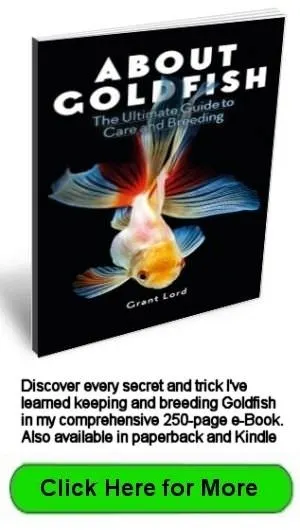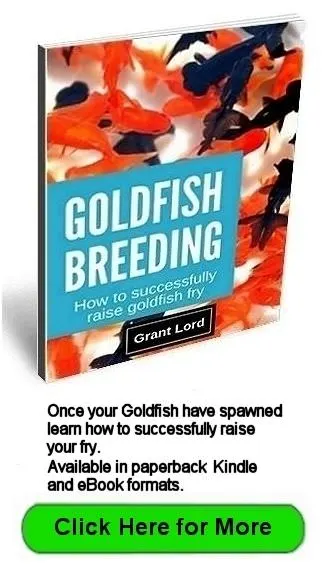- Home
- Aquarium Filters
Aquarium Filters
There are a wide variety of aquarium filters that can be used in goldfish aquariums.
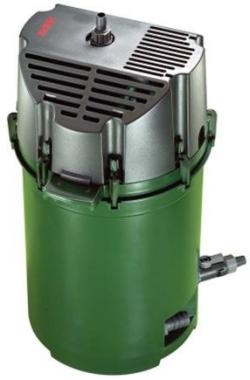
How to choose the best filter for your goldfish aquarium, after deciding on the size of your set up and how much maintenance you want to do.
The Purpose Of Filtration
The purpose of a filter is not only to make the water clean and clear. That is a secondary benefit.
A filter’s primary purpose is to process the waste (ammonia) generated in the aquarium and convert it to more harmless nitrates
The Nitrogen Cycle
Over time, large numbers of useful bacteria colonize the filter media and process the waste from the water. This is called the nitrogen cycle, and all new aquariums must go through it.
Until these bacteria colonize the filter in sufficient numbers, any ammonia from waste will pollute the water and harm the fish.
Fish are very sensitive to ammonia levels.
Go to the page on setting up an aquarium to read more about the nitrogen cycle and how to test for it.
An Aquarium Filter Is Your Best Friend
Having established that an aquarium filter is an essential piece of equipment that reduces the amount of maintenance you need to do, and provides some level of protection against mishaps, the decision now is to decide which one best suits your setup.
Choosing The Right Aquarium Filter
Goldfish are messy bottom feeders, producing a lot of waste. Some filters are more efficient than others, so you need to choose the correct filter to avoid having to clean it out too often.
An aquarium filter well suited to a setup shouldn’t need cleaning out more than three or four times a year.
As a general rule, the water should be turned over at least four times per hour. Most power filters will give a gallons or liters per hour figure. This figure will be for a new filter that is unclogged. Always go bigger with a filter rather than smaller to allow for efficiency to drop over time as the filter gets clogged.
You can never over filter an aquarium but you can certainly under filter one.
Aquarium Filter Types
There is basically two ways filters move water:
- Using air bubbles to lift water up a tube
- Using an electrically powered water pump.
Filters that have electrically powered water pumps generally move far more water than do air powered filters.
External Canister Filter
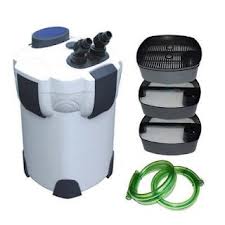
These filters sit outside the aquarium. Most canister filters have an integrated water pump that sits on top of the canister body, but larger very high capacity types can have the water pump situated away from the canister and connected by hoses.
They have three or more trays or compartments for filter media.
Advantages:
- They come in many different sizes to suit any aquarium
- Easy to get at for maintenance
- Very efficient if the correct filter media is used
- Quiet in operation
- Can come with an internal heater
- Can come with a UV sterilizer.
Disadvantages
- Inlet and outlet hoses need to be in the aquarium
- You need room close to or under the aquarium for the filter
- Some come without filter media.
External Hanging Filter
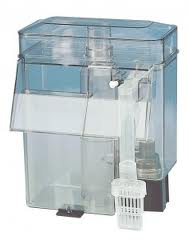
These filters hang from the side of the aquarium, usually the back. They have a small pump that sucks up water from the aquarium which then goes through a series of chambers before returning to the aquarium.
Advantages:
- They come in a range of sizes but are more suited to smaller aquariums
- Easy to get at for maintenance.
Disadvantages:
- Many of these filters only have a sponge insert, thus limiting the filter media that can be used.
- They aren’t as efficient as a canister type filter.
- The returning water can be noisy
- There has to be sufficient room at the back of the aquarium.
Under Gravel Filter
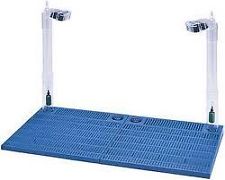
These filters sit underneath the aquarium gravel.
They usually use air bubbles to move the water, but in bigger installations power heads (water pumps) are used.
They work by pumping air down a small tube into the base of a larger tube. The air returns to the surface as bubbles. This action draws water up the larger tube. The water has to pass through the gravel before it returns to the aquarium. The gravel is used as the filtering medium.
Note: Bigger installations that use power heads pump the water down the tubes forcing the water up through the gravel.
Advantages:
- Low maintenance.
Disadvantages:
- Not suitable if you want to use sand as your substrate.
- The gravel has to be deep enough so some of it is always left undisturbed
- More suited to setups that have smaller fish
- The gravel or substrate must be large enough to allow sufficient water to pass through easily, but small enough to encourage bacteria colonization
- Plant roots can clog them up over time.
- The aquarium has to be stripped if the filter gets clogged.
- Hard to detect filtering efficiency drop.
Internal Corner Box Filter
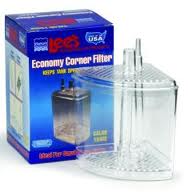
These filters use air bubbles to move the water, similar to under gravel filters. The filter media is usually sponge material. They are used mainly in smaller aquariums.
Advantages:
- Low cost
Disadvantages:
- Take up aquarium space
- Limited filter media can be used
- Low efficiency.
- Hard to detect filtering efficiency drop.
Internal Sponge Foam Filter
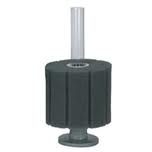
These filters are similar to the internal box filter but don’t have a plastic body. They either sit on the bottom or can be attached to the aquarium side with rubber suckers. Sponge material fits around a perforated tube. Air bubbles are released at the base of the tube and as they flow upwards to the surface, they drag water through the sponge material.
These filters are often used for fry aquariums as the fry can’t get sucked into the filter body.
Advantages:
- Low cost
- Excellent for fry
- Don't filter out live foods before they are eaten.
Disadvantages:
- Take up aquarium space
- Limited filter media can be used
- Hard to detect filtering efficiency drop.
Internal Power Filter
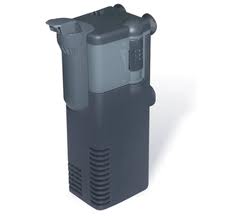
These filters sit on the bottom or attach to the side of the aquarium using rubber suckers. Most use sponge material as the filter media.
Advantages:
- No hoses or tubes in the aquarium
- Simple to install.
Disadvantages:
- Take up aquarium space
- Limited filter media can be used.
Under Cover Filter
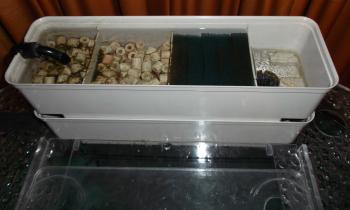
These filters are becoming more popular in larger setups, and usually come with the aquarium. A power head pumps water up into a tray or trays that sit on top of the aquarium, usually under the cover.
The tray is divided into sections that can have different filter media in each, similar to a canister filter.
Advantages:
- Hidden from view (apart from the intake tube and power head)
- Never clog as the water just flows over the top of a clogged section and back into the aquarium
- Easy to maintain
- Can have multiple trays (as in the example above)
- Very efficient due to the media being partially exposed to air.
Disadvantages:
- The aquarium cover has to be high enough to accommodate the tray(s).
There are a few other specialist filters such as wet/dry filters and protein skimmers, but these are for sophisticated setups and aren’t necessary for the majority of aquariums.
Buying Your Aquarium Filter
If you need an aquarium filter, Amazon.com have a wide selection at competitive prices.
If you want a quality product that will last and have spares available, choose one of the well known brands such as Eheim and Fluval. Yes they are more expensive, but some of the Asian sourced products I have tested start showing pump rotor wear after just six months.
If you decide to purchase one of the cheaper external canister brands, check the groove where the sealing ring sits very carefully. I have found poor finishing often leaves small amounts of material in or around the groove stopping the sealing ring seating correctly, leading to leaks.
I would strongly advise testing a cheaper filter first, maybe outside using a bucket as a substitute aquarium, so if the filter leaks it won't do any damage to flooring or furniture.
Filter Cleaning
When your aquarium filter needs cleaning, there is a set procedure to follow to avoid destroying all the beneficial bacteria living in the filter. To learn how and when to clean aquarium filters correctly go to this page…
To learn about what filter media you should use and where to place it in your filter click here...
